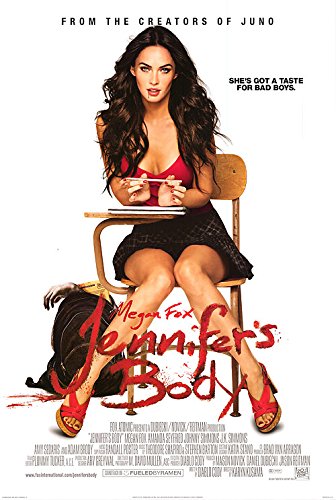A marketing horror story. Based on a misunderstood film.
It’s 2009. You’re on your way to the movie theater. Boom Boom Pow by The Black Eyed Peas is playing on the radio. You pay for overpriced popcorn and watch Jennifer’s Body. You go home. As you scroll on tumblr before bed, you reblog a gif of Megan Fox and mention how much Jennifer’s Body sucked. But did it really?
Who would’ve thought the film would be considered a cult horror for feminists and the LGBTQ+ community years later. Little did everyone know at the time that the intended audience for the film wasn’t fratty Megan Fox fanboys. It was for young girls like Needy and Jennifer.

The story focuses on two lifelong best friends in Devil’s Kettle, Minnesotta. Jennifer (Megan Fox) is a popular cheerleader and Needy (Amanda Seyfried) is a reserved nerd who shyly follows Jennifer’s shadow. One night, the two go out to see an indie band at a local bar. After the bar suspiciously catches on fire, Jennifer catches a ride home with the band despite Needy’s objection. The band ends up gruesomely sacrificing Jennifer as part of a satanic ritual in exchange for fame. As a result, Jennifer becomes a demonically possessed “man-eater. When Needy learns about what happened, she struggles to stop her best friend from killing their male classmates.
So we have a feminist comedy-horror written by Diablo Cody (Juno) and directed by Karyn Kusama (The Invitation). Where did it go wrong?
Horrific Marketing
The whole marketing campaign for Jennifer’s Body was geared towards young straight males. Only 2 audience groups were recruited for test screenings, those who were fans of Juno (Cody’s previous film) and white males between the ages of 18-24. One of the written reviews they received after the screening said “needs more bewbs.”
“That was the data that was collected and taken seriously by the people who were marketing the movie.”
Diablo Cody

Movie posters and trailers for Jennifer’s Body entirely focused on Megan Fox’s sex appeal. When Cody emailed questions about the campaign to the studio, the only response she received was “Megan Fox hot,” which is very telling of how much the studio valued the film. In an interview with BuzzFeed News, Kusama revealed that the studio suggested to have Fox host an amateur porn site to promote the film. The studio clearly had a different target audience from the filmmakers.
2009 was also a difficult time for Fox to promote the film. She was already being sexualized in the media and then fell under constant scrutiny after speaking up about her experience on Transformers.
After its release, critics tore the film apart along with Cody and Kusama’s careers. Fox and Cody reunited years later to discuss the aftermath of Jennifer’s Body.
“Hell is a Teenage Girl”
Critics failed to understand the film underneath the witty dialogue and tropes. Jennifer’s Body explores themes like toxic female friendships, trauma, and women’s sexual and emotional desires. “I knew I was making a movie about girls I knew, and I wasn’t making them for anyone’s sort of voyeuristic pleasure. I was actually wanting people to kind of confront the beauty and the ugliness of girls at this age,” Cody said. The sacrifice scene where Jennifer begs for her life as the band laughs before stabbing her chillingly represents how victims of violence are treated and how abusers get away with it.
The studio misunderstood such themes when marketing the film, thus greatly affecting audience perception.

Reappraisal by Feminist and Queer Audiences

Fast forward to today. Many thank the infamous make out scene for their gay-awakening but there’s actually a lot of queer subtext throughout the film. You can easily tell that Jennifer and Needy share something that’s more than friends despite the two appearing straight. Just observe their obvious body language and codependency. Jennifer seems to dislike any person Needy is interested in including her boyfriend, Chip. This drives Jennifer’s potentially subconscious jealously to seduce and kill them. In an attempt to seduce Needy, Jennifer alludes to their intimate relationship by saying things like “but we always share your bed when we have slumber parties,” and “we can play boyfriend-girlfriend like we used to do.” As Needy said in the beginning of the film, sandbox love never dies right? Cody even said herself that she wrote the kissing scene to show Needy was in love with Jennifer to some extent.
And let’s not forget the more intentional and iconic line after Needy asks, “I thought you only murdered boys?,” in which Jennifer responds, “I go both ways.” A possible hint at Jennifer’s bisexuality.
It’s safe to say that Jennifer’s Body was ahead of its time and people weren’t ready for a film like that back then. Society has evolved since the film’s release which could contribute to the audience shift in perception. Those misunderstood themes and tonal shifts are more prevalent in Hollywood now. Some people were also too young to see the film back then and are barely discovering it. Others are reassessing the film and now consider it timely. Whatever it may be, Jennifer’s Body definitely deserved better marketing and understanding.
Luckily at Filmocracy, we actually give a sh*t about filmmakers and underrepresented stories. Our streaming site was created to give independent filmmakers an alternate platform to reach their audience. We also reward viewers for their ratings and reviews with virtual currency that can be used to redeem real prizes. Click here to start earning rewards today.


Pingback: 6 Cult Classic LGBTQ+ Films You Need to See - Filmocracy Blog
Pingback: 7 Genre Defying Queer Feature Films - Filmocracy Blog